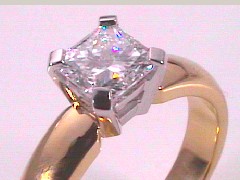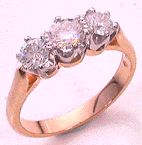 Diamonds
have been treasured since antiquity for their natural sparkle.
Diamonds
have been treasured since antiquity for their natural sparkle.
Diamond is also the stone best suited to daily wear because its the hardest known naturally occurring material. It can only be scratched by another diamond, it maintains its polish extremely well, keeping its lustre over long periods of time.
Platinum is the the best precious metal to set your diamond in, but yellow gold and white gold are also used.
Round Brilliant cut diamonds produce the most sparkle, but the elegance of the Princess cut appeals to many people.
Style is a personal choice whether it be Solitaire or 3 stone, rubset or claw set, yellow or white, shoulder stones or plain. Make sure you are comfortable with your choice because you will wear it for a long time. Also check that a wedding ring can be worn alongside.
Diamond Quality
Diamonds are graded according to their weight, colour, clarity and cut. Weight is measured in carats where 1ct = 0.2gm. and 1ct is divided into 100 points. Colour is described using an alphabetical scale from D to Z with D being colorless and Z being yellow. A grade of J or more will mean the diamond is tinted. Clarity is a measure of imperfections within and on the surface of the diamond. Be aware that in the top 8 grades the imperfections are only visible using a 10 power lens. Cut not only refers to the shape of the stone but also the finish, symmetry and proportions. A diamond may be D colour and flawless but will only truly sparkle if it is cut to a certain formula.
Weight
Diamonds are weighed in carats, where 1 carat equals 200 milligrams. A carat is further divided into "points". There are 100 points to a carat.
The word carat derives from the Greek keration (fruit
of the carob), via Arabic and Italian. Carob seeds were used as
weights on precision scales because of their uniform size. In the
distant past, different countries each had their own carat,
roughly equivalent to a carob seed.
Eventually, it was linked to the grain in the Troy pound system
of measurement. Under this system the standard was about 205
milligrams. Metric countries used this measurement nonetheless in
its limited range of application. In 1907 the metric carat of 200
milligrams was adopted, and is now universally used today.
Note: Just to be confusing the term carat is also used to describe the proportion of gold in gold alloys. The spelling in this instance is normally changed to karat
Colour
The GIA grading system for colour
| D | E | F | G | H | I | J | K | L | M | N | O.P Q R S T U V W X Y Z | |||
| colourless | near colorless |
faint colour |
increasing colour |
|||||||||||
Clarity
The GIA system for grading clarity
| FL | IF | VVS1 | VVS2 | VS1 | VS2 | SI1 | SI2 | I1 | I2 | I3 |
| flawless | internally flawless |
very very slight | very slight | slightly | included | |||||
In grades down to SI2 any imperfections are only visible with a 10 power lens ( except in larger stones where a visible inclusion may be allowed ). I2 and I3 grades should be avoided - usually because the inclusions are very obvious and may be a danger to the integrity of the stone
Cut
A diamond can be cut in many different shapes , Brilliant Cut
(Round), Marquise, Pear, Princess, Oval, Emerald, Square Emerald,
Radiant, Square Radiant, Triangle and Heart to name a few.
But Cut in terms of quality is the factor which determines the brilliance,fire and scintillation - the optical properties that describe how good a diamond looks. The stone is also measured for symmetry, proper formation of all facets, girdle thickness and the quality of the final polish.
Brilliance/ Brightness is the effect of all the diamond’s internal and external reflections of white light. Well-cut diamonds are brighter than poorly fashioned ones, even if they’re of equivalent size, color, and clarity. In general, the brighter a diamond, the higher its cut grade.The proportions of the stone play the biggest role in determining brightness, the most important being table percentage, crown angle and pavillion angle. However Various combinations of these proportions can produce high levels of brightness so there is no perfect cut.
Fire results when white light traveling through the diamond is dispersed into a rainbow of spectral colors. It’s the most difficult of a diamond’s optical qualities to evaluate, and is especially challenging to assess in smaller diamonds (eg 0.50 ct.).
Scintillation is a combination of sparkle and
pattern. Sparkle is the spots of light that flash as the diamond,
the observer, or the light source moves. In an attractive
diamond, the flashes should appear even and balanced in size.
Pattern is the relative size, arrangement, and contrast of the
bright and dark areas that result from a diamond’s internal
and external reflections. The pattern of bright and dark areas
should be well balanced, and there must be enough contrast to
give the pattern a crisp, sharp look.
Precious Metals
Platinum is the best metal for jewellery because its naturally white and shows off the diamonds brilliance. It is also extremely hardwearing. Normally used 95% pure. (look for 950 stamp inside ring band). For more platinum rings
Palladium is another white metal in the platinum family
Gold is alloyed with other metals to make it harder. Normally used 75% pure (18k). May be stamped as 750, 18k or 18ct. Other alloys are 8k, 9k, 10k, 14k and 22k. Alloyed with white metals a white gold alloy is produced but it is not a bright white and is usually plated with Rhodium.
Ring Quality
Having carefully chosen your diamond don't let your guard down when selecting a ring. A lightly constructed ring will wear much quicker than a properly made one.All visible parts of the ring should be polished and free of any scratches.
Parts of a ring
Setting - the part that holds the stone. Different styles of setting are Claw, bezel (rubset ), tension, channel, pave, bead, star
Shoulder - part of the ring either side of the setting
Shank - part that goes round the finger
Care and Cleaning
A Diamond will quickly lose all its sparkle if it gets dirty. We recomend regular brushing with an old toothbrush and detergent in warm water. Rinse in clean water and pat dry. Small ultrasonic cleaners are available for home use (not suitable for some gems eg Emerald )
Whilst Diamonds are the hardest natural material known, they are not the toughest. Contrary to some old tales they will break if struck with a hammer. So we recomend taking your rings off when the going gets rough. Exposure to harsh chemicals like chlorine and bleach should be avoided as well.
Rings are often damaged by another ring worn alongside. If one has protruding claws or edges, lines or grooves will appear in the other ring, and eventually the wear become so serious that a major repair is necessary. If you see wear marks on the sides of your ring, separate them by buying a spacer or put one on another finger.
A jeweller can restore your ring to new condition by repolishing the metal and cleaning the stones.
Valuation
Insurance companies require a written appraisal/valuation on
all valuable jewellery, watches, antiques and fine art. An
appraisal ensures adequate compensation or your jewellery
replaced in the event of loss.
Jewellery should be appraised often to take account of changing
market values. If current market value is not a major concern, an
up-to-date appraisal of your jewellery and other valuable items
should be obtained every two to three years. It is suggested that
you should supply any helpful information such as a gemstone
report, previous appraisals or sales certificates at this time.
Jewellery items worth more than $1000 that have not been
appraised for three years may not be covered by your insurance
company.
Keep an inventory of all jewellery and where possible keep
receipts and details of when and where the item was purchased.
History
In ancient times, wedding bands occupied the third finger on the left hand just as they do today. The significance of the third finger was the belief that the vein in the third finger, the "vena amoris," led directly to the heart. This idea was attributed to the Egyptians and adopted as truth by the ancient Greeks and Romans, until later disproved.
The concept of an engagement period may have begun in 1215 at the Fourth Lateran Council, headed by Pope Innocent III, which decreed that "marriages are to be . . . announced publicly in the churches by the priests during a suitable and fixed time, so that if legitimate impediments exist, they may be made known." . The modern practice of giving or exchanging engagement rings is first documented in 1477 when Maximilian I, (later Holy Roman Emperor) gave Mary of Burgundy a diamond ring as an engagement present.
The present tradition of diamond engagement rings can be traced to a De Beers marketing campaign in the 1930s.
Conflict Diamonds
Be sure to ask whether the Diamond comes from a legitimate source
In many African countries, including Angola, Sierra Leone and the Democratic Republic of the Congo (DRC) diamonds have been used by rebel forces to finance arms purchases and other illegal activities. Neighbouring and other countries can be used as trading and transit grounds for illicit diamonds. Once diamonds are brought to market, their origin is difficult to trace and once polished, they can no longer be identified.
links page
